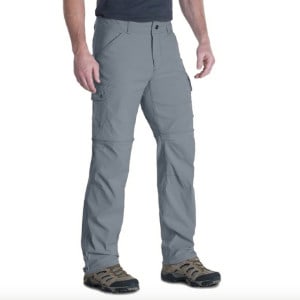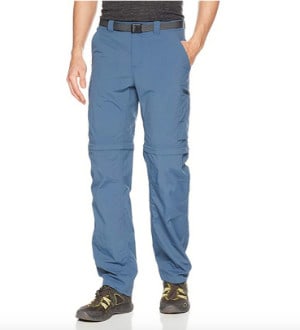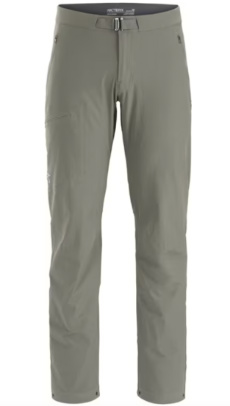Hiking pants are an important piece of hiking gear but one that men often take for granted. They have to be highly breathable, durable, quick-drying, and easy to vent when you get too hot, but warm when the temperature drops. Fit, freedom of movement, and pockets are also key factors. What about hiking pants that are insect resistant or provide a high degree of sun protection? All of these are important variables when choosing the best hiking pants.
However, no one pant will suit everyone’s body type. Some hikers prefer a slimmer fit that reduces extra fabric while others feel more comfortable and airy with a looser fit. Particular features to look for include articulated knees and a gusseted crotch, lots of pockets, and venting options such as roll-up legs or convertible pants. With these variables in mind, here are the top 10 men’s hiking pants we recommend.
1. KUHL Renegade Cargo Convertible Pants
2. REI Sahara Convertible Hiking Pants
3. Columbia Silver Ridge Convertible Hiking Pants
4. Arc’teryx Gamma Pants
5. prAna Stretch Zion II Pants
6. Patagonia Quandary Pants
7. Outdoor Research Ferrossi Convertible Pants
8. Eddie Bauer Guide Pro Convertible Hiking Pants

Eddie Bauer’s Guide Pro Convertible Pants ultralight guide pants are ideal for hiking, climbing, and travel. Pretreated for odor resistance (good for 20 washings), they have a UPF rating of 50+ for sun protection in the hottest climates. These pants are made with a mix of nylon and spandex that makes them ideal for rock climbing and scrambling, with two zippered security pockets on the legs to hold your essentials close at hand. The fit is “athletic” and runs slightly long, with 10″ long shorts, when the legs are unzipped.
9. RailRiders Eco-Mesh Pants
10. Duluth Trading Company Dry on the Fly Pants
Hiking Pants Selection Criteria
Consider these variables when buying hiking pants.
Weight & breathability
For summer hiking, you want a breathable, lightweight fabric that will help you stay cool. You may want three-season pants, or ones you can layer for winter, but if you plan on hiking at the height of summer, buy for that. Overheating will make you miserable, or worse. Most hiking pants are fully synthetic, which helps them dry out quickly when you sweat. Some also incorporate mesh panels and/or pockets to help airflow.
Long pants, convertible pants, or roll-ups
Your choice will depend on both your comfort preferences and the type of hiking you’ll be doing. If it’s going to be hot, and you are backpacking with just one pair of pants, convertible pants will give you the most options for day and night. But if you know you will not want shorts, because of sun exposure, bugs, or terrain that will beat up your legs, convertible pants are unnecessary and will add bulk. In other words, consider your terrain and habits when you choose. If you do choose convertible pants, test the zippers and look for ankle zips, too, which let you take the lower legs on and off without removing your shoes. An alternative to fully convertible pants, roll-up legs–typically held up with a snap or button–can provide extra ventilation on a hot day.
Pockets and Extra Features
Extra features can make a good pair of pants into a great pair of pants. Secure, well-designed pockets give you easy access to essentials like your phone or map without rummaging through your pack. Well-placed waistbands won’t chafe under your pack’s hip belt. Reinforced pant cuffs can help prevent fraying.
Stretch
You’ll also want to look for stretch, especially if you’ll be hiking in scrambly terrain. If you have to get your legs up and over obstacles, you’re going to want to give in the fabric. Most of the pants listed here blend nylon with spandex or elastane to provide that stretch, but the ratios differ. Typically, the higher the spandex or elastane content, the more flexible the fabric. A cotton blend can also offer good mobility, as with the Mountain Hardwear AP Pants and the Fjallraven Vidda Pros on our list.
Durability
Aside from the durability of the fabric itself–which you learn through gear reviews along with trial and error–features that increase durability include reinforced seams as well as reinforced knee and rear panels. Heavier fabrics, or those with a tighter weave, may be more durable, but that also needs to be balanced against breathability in the summer months.
Sun protection
All clothing will provide some protection from direct sun, but some fabrics provide more than others. Many manufacturers have started listing UPF (ultraviolet protection factor) ratings on their clothes. This tells you how much of the sun’s ultraviolet rays penetrate the material. For example, if a garment’s UPF rating is 50, that means 1/50, or 2 percent, of the sun’s UV rays, reach your skin through the cloth. UPF 20 means that 1/20, or 4 percent, of the sun’s rays, get through. The higher the rating, the better the protection. Fabric type, weave, dyes and added chemical treatments can all affect UPF.
Insect protection
Fabric treated with insect repellents such as Permethrin can help keep the biting critters away. This can be especially helpful in high tick season. Few of the pants on our list this year are treated with repellent, but it is not a hard process to do on your own. (Permethrin is known to be dangerous to cats, so if you treat clothing at home, be careful with the chemical. Once you have finished treatment, however, the clothes are safe.) See here and here for info on treating clothes yourself.
Water protection
Durable water repellent (DWR) coating is common in hiking pants, as you’ll notice in our top ten list. It won’t make the pants waterproof, but it will help them shed water, and delay, if not prevent a soaking. That said, the coating wears off with wear, tear, and washing, so you’ll eventually need to refresh or re-apply it, which you can do safely at home with the right products.
Check Out All of SectionHiker’s Gear Guides!
SectionHiker is reader-supported. We only make money if you purchase a product through our affiliate links. Help us continue to test and write unsponsored and independent gear reviews, beginner FAQs, and free hiking guides.









